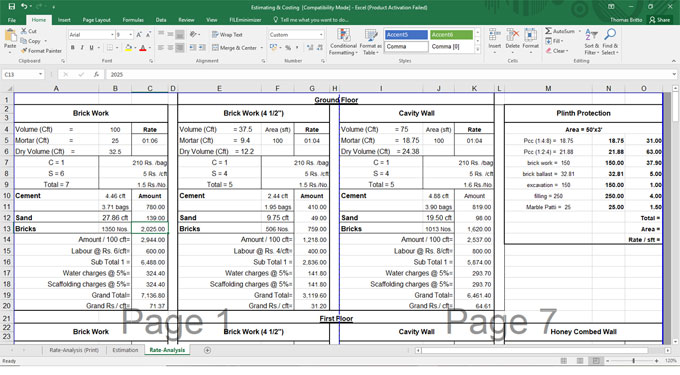
Details about the rate analysis of concrete work
The rates are created by the engineering departments on the basis of the market rates for the payments which are called Schedule of Rates.
It comprises of the rates of cement, sand, gravel, and steel bars, etc. Besides, it also provides the rates of labor or material. The rates of labor are defined as Labor Rates.
Rates of labor together with the materials are termed as Composite Rates alias CSR. Schedule of Rates is provided frequently based on the changeability of the rates in the market. It is provided at the beginning of each year that will be achievable for minimum three months.
It is called Market Rates Schedule that is uploaded on the Internet and defined as MRS in short term. Rates are examined for any establishment that is called Analysis of Rates.
Rates are likely to be raised even after circulation of the Schedule of Rates. For this reason, the extra rates settled throughout agreement with the contractor and it is called Premium. Rates are likely to be reduced even after circulation of the Schedule of Rates.
Reduced rates are settled throughout agreement with the contractor that is called Rebate.
Rate Analysis is done for the following purposes :-
1. To find out the cost of construction in Per Unit as per the Specifications.
2. To find out the entire cost or budget of the building.
3. To measure the impact of market rates on payments provided for constructional work.
4. To create identical standards for constructional works accomplished in limits of government and engineering departments.
5. To set up the amount of Rebate or Premium over departmental payments.
Rate Analysis of Concrete Work: For analysis of concrete work, 100 cubic feet is considered as Unit of Rate.
Cost of materials for concrete materials, cost of labor and the cost of carriage are taken into consideration throughout the analysis of concrete work. Primarily, unit of Rate is briefly examined to find out the quantity of material for concrete in wet form.
This quantity is multiplied with 1.54 for the purpose of changing the concrete volume in dry form. Concrete volume is raised as cement fills spaces in the sand and obtained mixture fills space in gravel.
So, the volume of individual concrete materials makes deterioration in the entire volume of the concrete. A reduction in concrete volume Is based on the ratio of concrete as well as the size of gravel and sand.
The volume of dry materials facilitate determining the quantities of concrete materials like cement, sand (fine aggregate) and gravel (coarse aggregate).
So, the proportion of concrete materials is obtained primarily with the following formula. Quantity of Material = (Ratio of Material / Sum of Ratio) x Dry Material of Concrete.
Once the quantities of all of the materials are obtained, their cost is measured based on the current market rates. Then, the cost of labor is also obtained for related concrete work.
At last, the carriage cost is computed. The overall cost for one unit is worked out by collecting all these costs and adding the profit of the contractor.


